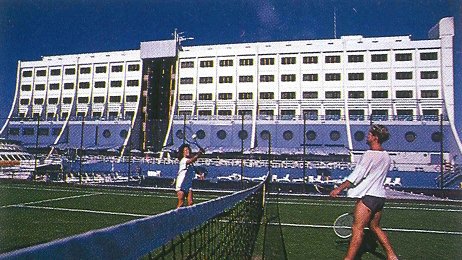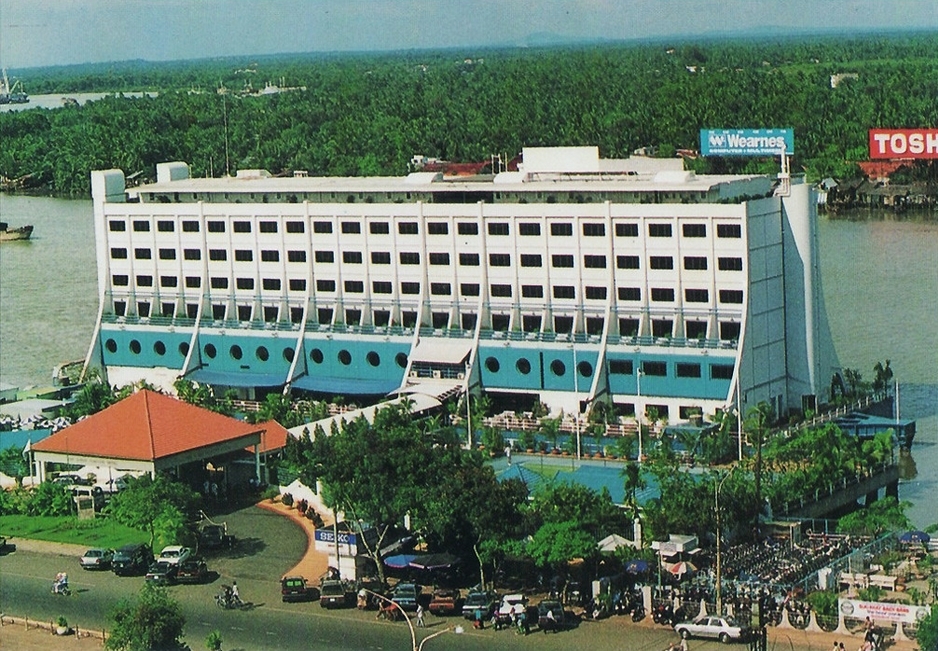North Korea is somewhat famous for its hotels. The most famous of course being the historic tourist hotel of the DPRK – The Yanggakdo hotel in Pyongyang. Standing at a whopping 47 stories and boasting bowling alleys, casinos and over 1000 rooms, the Yanggakdo hotel towers over the skyline of the capital city. However, did you know that North Korea owns a piece of hotel history? Docked in the Mount Kumgang region sits the world’s first-ever floating hotel. How did it get there?
A floating hotel you say?
Pictured Above: The Four Seasons Barrier Reef Resort in Australia
Built-in Singapore and delivered to Australia in 1988, the floating hotel was the bright idea of Australian developer Doug Tarca and his son Peter. The hotel was intended to be an exclusive holiday destination for wealthy Australians and foreign tourists with money to burn. Originally named ‘The Four Seasons Barrier Reef Resort,’ the hotel was moored on the John Brewer Reef, about 70km off the coast of Townsville, Queensland. The resort included over 200 rooms, floating tennis courts, glass-bottom boats, bars, nightclubs – you name it, it probably had it!
Unfortunately, as good of an idea as a floating hotel over a huge coral reef sounds, it definitely came with its fair share of problems!
What could go wrong with a floating hotel?
Well, quite a few things, actually! Before the hotel was even open for guests, the construction of the hotel was around six months behind schedule after a few disagreements with the construction firm, which contributed to costs totting up to around $40 million. A few weeks before the hotel was due to open a huge cyclone obliterated the hotel with heavy winds, which left the planned outdoor freshwater swimming pool in pieces. When the hotel eventually opened for business, it had already lost millions of dollars in lost revenue due to it being so far behind schedule.
The bad luck with the weather continued, and it was really starting to cause the resort a lot of issues. Getting to the hotel involved boarding water taxis or flying in via helicopters. Obviously, any excessively high winds or rough waters would disrupt these connections, leaving some guests with no option but to cancel their stays. Adding to their transportation woes, one of the water taxis used to transport guests caught fire. Thankfully nobody was seriously hurt, but you can imagine the extra damage that caused for the already weakened public image! Tie that with a string of poor marketing decisions, weak management and the discovery of over 100 tons of World War 2 ammunition and mines on the ocean floor about two miles from the resort bookings soon dried up, despite offering some seriously reduced rates. The hotel eventually became too expensive to operate, and just over a year after it opened, it was closed – just like that!
Where did this hotel float to next?
Pictured Above: Saigon Floating Hotel
After the hotel closed its doors in Australia, the hotel was sold to a Vietnamese company. It was towed to Saigon, where it opened as the Saigon Floating Hotel. Vietnam was going through a tourism boom following the end of the Vietnam War, so the demand was there for more luxurious hotels to attract foreign tourists. The hotel was originally very successful and was open for nearly ten years whilst moored on the banks of the Saigon River. It became known as a popping nightspot in the city, and was often referred to as ‘the floater.’
However, the hotel seemed to be plagued with financial issues and, once again, was forced to close. It’s believed that newer high-end hotels opening up around the city meant the boat simply became outdated and overpriced, which lead to its door being closed in 1997.
How does a floating hotel end up in North Korea?
Pictured Above the Haegumgang Hotel in North Korea
A bizarre turn of events saw the hotel embark on a 14,000-kilometre journey to Korean waters. The hotel was sold to Hyundai Asan – a South Korean company – who were helping to develop the Mount Kumgang tourist resort in the North, a border region where South Koreans were free to visit. The hotel was renamed to ‘The Haegumgang Hotel’ and was mainly aimed at South Korean tourists.
As was the case in Vietnam, business was booming, with plenty of tourists flocking to the region. However, the hotel’s bad luck streak continued! The Haegumgang Hotel was forced to close in 2008 after some tensions in the area, and subsequently, all tours from the South to the resort were suspended. To this day, the hotel has remained moored in Kumgang, where it has been left to deteriorate and ultimately reduced to a big ugly rusty mess.
What’s next for the floating hotel?
Pictured Above: The Mount Kumgang Region including the Haegumgang hotel in 2019
The future of the hotel looks bleak! Marshal Kim Jong-Un visited the region in 2019, where he heavily criticized the facilities. He’s quoted as saying that the facilities look shabby as they are not properly cared for, and he called for the “unpleasant-looking facilities” to be demolished and rebuilt to “meet the DPRK’s own sentiment and aesthetic taste.”
Demolition and redevelopment of the region have been postponed due to COVID-19, so the hotel lives to fight another day! However, demolition seems likely to be on the horizon for this historic floating hotel.
We run multiple tours to North Korea and Kumgang. Have a look for a tour that suits you and get in touch! You can secure YOUR place now with no deposit, or you can take advantage of our Young Pioneer Tours Membership Program from as little as €60.









